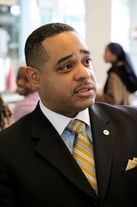
Farrakhan and the Hadith of the Black Man Who Destroys the Ka’bah
September 2, 2013 at 5:58pm
By Wesley Muhammad, PhD.
In the recent edition (Part 34) of this most important lecture series, “The Time and What Must Be Done,” the Honorable Brother Minister Farrakhan makes the following, deeply profound statements:
“My dear brothers and sisters of our Islamic world…whether you know it or not the rightful place for the righteous (i.e. Mecca and Medina) will be bathed in blood as a purifying agent for the Mahdi and the Messiah to bring the real people of God back to their proper and rightful place in Mecca, in Medina, and the whole Muslim world…the real owners of that land will one day be coming home. And Allah says He will take the kingdom from whom He pleases and He will give it to whom He pleases. This is the promise of Allah…I read a hadith, I don’t know if it’s a true hadith…but it struck me while I was in Arabia, when I read it. It said, ‘One day a Negro will come at the head of 10,000 and he will destroy the Ka’bah.’ I asked myself, why would anyone destroy this ancient house of worship for the one true God? And the deeper I thought, I said it could be because that ancient house is a sign of something greater than itself. And when the sign has been fulfilled, then the sign need not be anymore.”
There are layers upon layers of wisdom in these words. I want only to provide some hadith materials relevant to Brother Minister Farrakhan’s statement, particularly as these materials relate to the specific hadith that he quotes. After listening to these words by our Minster and then grabbing the relevant materials from my library and reviewing them, I said to myself: “Farrakhan is a divinely guided man.” I had been very familiar with the hadiths that the Minister alludes to, but to be frank I really did not know what to make of them. The Minister’s words have brilliantly illuminated these hadith reports for me and for us and I am not sure that, as of right now, he is fully aware of just how much light he has shed on a whole set of hadith materials.
There is a set of apocalyptic hadith reports according to which at or near the End of Time a group of Ḥabash, literally ‘Abyssinians’ or Ethiopians, led by a particular Ḥabashī or ‘Ethiopian’, will invade Mecca and effect the complete destruction of the Ka’bah.[1] Aḥmad b. Ḥanbal (d. 855) reports in his collection, Musnad (II:220, I:227), for example:
‘Abd Allah b. ‘Amr (ra) related that he heard the Messenger of Allah say, “Dhū l-Suwayqatayn, who is from Ḥabasha, will destroy the Ka’bah; he will take its treasures and remove from it its covering (kiswa). It is as if I am looking at him – (he is) bald (or: “with a receding hairline”) and has a distortion in his joints. He will strike it (the Ka’bah) with his steel shovel and his axe.
(‘Abd Allah) b. Abbās narrated that the Prophet (s) said: “It is as if I can see him now: he is black and his legs are spaced. He will destroy the Ka’bah stone by stone.
According to a report in al-Bayhaqī’s (d. 1066) collection, this Black man will be sitting on the Ka’bah on a mat taking it apart, stone by stone.[2] I will discuss the Black man’s name (Dhūl-Suwayqatayn) and some of the details of his description below. Right now I want to cite a few more relevant reports.
The Iraqī hadith scholar Abū Dāwūd al-Ṭayālisī (d. 819), in his Musnad (312-313), reports that the famous Companion of the Prophet, Abū Hurayra (d. 681), warned the Arabs that if they violate the sanctity of the Ka’bah they will perish and the Ḥabash will come, destroy the Ka’bah, and dig out its treasures. It is also reported that Anas b. Mālik (d. 712), another famous Companion, while circumambulating the Ka’bah one day spoke to it (the Ka’bah), saying: “Verily, the Ḥabash will conquer you.”[3] A most remarkable report is recorded by al-Azrāqī (d. 827-839) in his Akhbar Makka (“Tales about Mecca”; 193): the Companion ‘Abd Allah b. ‘Amr b. al-‘Āṣ (d. 684) one day urged people to leave Mecca before one of two great calamities (iḥdā al-ẓalmatayn, “one of two darknesses” or al-ṣaylamayn, “two wars”) befell. The second of the two is “a massive raid by blacks who will come up from the sea and destroy the Ka’ba.” The leader of these Blacks will be bald (or possessing a receding hairline, aṣla’) and bowlegged (afḥaj), “as described in the Book of God,” says ‘Abd Allah. This means that the blacks who will conquer Mecca and their leader are written of the Qur’an.
These apocalyptic expectations at times produced significant anxiety among the people of Mecca. Ibn ‘Asākir (d. 1175) notes in his Tārīkh madīnat Dimashq (“The History of the City of Damascus”; IV: 584) that when the Qarmatian sect attacked Mecca in 929 and sacked the Ka’bah, some Meccans (many of whom are by this time white) went out of their homes to the Ka’bah to see if there was, as prophesied, a black man on the seventh arch of the mosque who will destroy the Ka’bah.
Who are these apocalyptic/eschatological Blacks and who is their leader, Dhū l-Suwayqatayn? The Blacks are of a particular type: Ḥabash. While this term initially was an ethnic/geographical term denoting Ethiopia and the Horn of Africa as well as the peoples of that area, it came to take on a very different, more peculiar meaning. To understand this peculiar meaning it must first be recognized that ‘Ḥabash’ does not mean and should never be translated simply as ‘Black’, as is often done. This is because the Arabs recognizedseveral different types of black-skinned peoples (al-Sūdān), including themselves. The Zanj of the southeastern coast were emphatically not the same as the Ḥabash, and both of these groups of Blacks were very distinct from the (ethnic) Arabs, who themselves unquestionably self-identified as Black (aswad, sumr, akhḍar). Al-Ḥusayn b. Alī al-Namarī (d. 996), in hisKitāb al-mulammaʿ, affirms:
Verily, Allah created five colors – white (bayāḍ), black (aswad), red (ḥumra), yellow (ṣufra), and green (khuḍra). He made four of these in humans (banū Ādam): white, black, red and yellow. He gave the Arabs, the Ethiopians (al-Ḥabash), the Zanj, and those who look like them in general – blackness (al-aswad)…And He gave the Persians, the Romans…and those that look like them in general – whiteness, redness and yellowness.[4]
In the famous declaration of the Prophet, “I was sent to the Red/White (al-aḥmar) and the Black (al-aswad),” White referred to the non-Arabs and Black to the Arabs. Thus, Ibn Abī al-Ḥadīd (d. 1258), in his famed Sharḥ nahj al-balāghah, notes regarding this prophetic statement:
He (Prophet Muhammad) alludes to Arabs by ‘the blacks’ and the non-Arabs by ‘the reds’, for the Arabs call non-Arabs ‘red’ due to the fair-complexion that predominates among them.[5]
Similarly, Ibn Manẓūr (d. 1311) in his Arabic lexicon, Lisān al-‘arab, quotes the following commentary on the Prophet’s statement:
i.e., the Arabs and the non-Arabs, for the predominant complexion of the Arabs is dark brownish black [al-sumra wa l-udma] and that of the non-Arabs is white [al-bayaḍ wa l-ḥumra].[6]
Arabs are (were) thus in the same general “black” category as the Ḥabash and other Blacks. But the Arabs, in a very enthocentric way, clearly distinguished their black skin from that of the rest of the Sūdān (“Blacks”) by a singular trait: their black-skin was abyaḍ (al-aḍdād), i.e. smooth, luminous (azhar), and free from the blemish and blotches (al-kalaf)[7] that supposedly characterized the skin of most of the other Blacks in Africa due to the excessive dry heat there.[8] The Zanj, the Nuba, and most (but not all) of the Ḥabash, it was claimed, lacked this defining trait, having very “sooty” and blotched skin due to their being “burned” in their respective parts of Africa. This distinction between Arab (Semitic) blackness and African (Hamitic) blackness is explicitly stated. The famed Muslim historian and Qurʾānic exegete al-Ṭabarī (d. 923) recorded in his Taʾrīkh al-rusul wa’l-mulūk the following tradition on the authority of ʿAbd Allāh b. ʿAbbās (d. 687), the cousin of the prophet Muḥammad:
The Children of Sam (Shem) settled al-Majdal, the center of the Earth, which is between Satidimā and the sea and between Yemen and Syria. Allah made the prophets from them, revealed the Books to them, made them beautiful, gave them a dark complexion, luminous and free of blemish (al-udma wa l-bayāḍ). The children of Ham settled in the south, along the course of the south and west wind-this region is called al-Dārūm. Allah gave them a dark complexion, a few of whom were also luminous and free of blemish…The children of Japheth settled in al-Ṣafūn, along the course of the north and east wind. They are ruddy-complexioned and very fair-skinned (al-ḥumra wa l-shaqra).[9]
This tradition of dark-skinned Semites and Hamites in contrast to fair-skinned Japhites of the north is found in Rabbinic Hebrew literature as well.[10] Al-Ṭabarī’s report claims that, while both Semites (Arabs) and Hamites (Africans) are dark-skinned, there is a distinction between the two complexions: the former’s dark complexion is characterized by being bayāḍ, i.e. free of blemish and imbued with a sheen or luminosity. On the other hand, the dark-complexion of most (but not all) Hamites (i.e. Africans) lacks this characteristic. The distinguishing characteristic between Arabs and Africans therefore according to this formulation is not chromatic but quality of complexion and absence or presence of a luster. A poet’s satirical reproach against the black-skinned ‘Ubayd Allāh, son of the Ethiopian Companion Abū Bakra, could claim regarding Nubian blacks: “God put no light in their complexions!”[11] This then sheds brilliant light (pun intended) on a much quoted hadith on the authority of Ibn Abbās:
A Ḥabashī man came to the Prophet (s) [wanting] to ask him [something]. The Prophet (s) said to him, ‘Ask whatever you wish.’ So he said: ‘O Apostle of God, you (pl.) surpass us in appearance (al-ṣūra) and complexion (al-alwan) and in prophethood. If I were to believe just as you believe, and if I were to do just as you do, would I enter Paradise with you?’ He said, ‘Yes.’ Then the Prophet (s) said: ‘I swear by the One who owns my heart, that the radiance of the Black person (bayaḍ al-aswad, i.e. the Ḥabashī) will be seen over the stretch of a thousand years.’[12]
The context is that of the different endowments between Semites and Hamites of somaticnūr (light). In Paradise, the Hamites (Ḥabash) too will possess their fair share and, like the Semites, their complexion will be both al-udma wa l-bayāḍ, “dark and luminous and blemish free.” The Arabs were indeed very ethnocentric about their particular black skin. It is only later, by the 9th and 10th centuries, that ethnic black Arabs all but disappear, squeezed out by ‘Arabized’ whites who converted to Islam and swelled the ranks.[13]
The term “Ḥabash” took on a special meaning distinct from “a native of Ethiopia or the Horn of Africa”: it came to specifically connote Blacks with non-Arabian African ancestry (but not necessarily origin) AND with freed slave status. Bilal is called al-Ḥabashī, “The Abyssinian.” But he was not born in Ethiopia. He was either born in Mecca or, more likely, Sirah in Yemen.[14] His father, Rabah, was an Arab. His mother Hamām, however, was from Ethiopia. It is this African ancestry but not necessarily African origin that is half of the meaning of “Ḥabash” as the term will develop. The other half: the second Rightly Guided caliph, Umar, was a black man (rajul ādam) too[15] and had, like Bilal, an Ethiopian ancestor: his paternal grandmother.[16] Yet, Umar is not referred to as al-Ḥabashī. Why? Because, though he was black-skinned with an Ethiopian ancestor (like Bilal), he was not a freed slave; he was part of the Arab nobility (he was a Qurayshī Arab). Slave and/or freedman status along with non-Arabian African ancestry were the key components of the meaning of ‘Ḥabashī’ by the time the hadith literature was compiled (ca. 8th -9th century). An actual origin in Ethiopia was no longer the primary connotation.
This means that this multitude of blacks (al-Ḥabash) who cross a sea (or body of water) to conquer Mecca are not actually Ethiopians but a people with an African ancestry who are also a slave or once slave (freed) people, like Bilal. Indeed, Bilal personifies this very people. When it is written that Muhammad heard the footsteps of Bilal enter paradise before his own, this signals not just Bilal’s personal precedence over the Prophet, but the precedence of the people personified by Bilal over the people (Arabs) personified by the Prophet. This “Ḥabashī“ precedence or preference over that of Muhammad’s people is nicely illustrated in another hadith. The great Qur’anic scholar al-Wāhidī (d. 1075), in his important text Asbāb al-Nuzūl, records the following report (re: Sura 49:3)
Yazid b. Shajarah said: “One day, the Messenger of Allah, Allah bless him and give him peace, passed by some of the marketplaces of Medina and saw a black slave standing while his seller was crying: ‘This is for sale for whoever wants to offer more!’ The slave kept repeating: ‘I have a condition for whoever wants to buy me’. He was asked: ‘What is your condition?’ He said: ‘He (who purchases) should not stop me from performing the five prescribed prayers behind the Messenger of Allah, Allah bless him and give him peace’. A man bought him on this condition. The Messenger of Allah, Allah bless him and give him peace, saw him at each prescribed prayer until he failed to see him one day. He asked his owner: ‘Where is the slave boy?’ He said: ‘He has fever, O Messenger of Allah!’ The Prophet said to his Companions: ‘Let us go and visit him’. They went and visited him. After a few days, the Prophet, Allah bless him and give him peace, asked his owner: ‘How is the slave boy?’ The man said: ‘O Messenger of Allah, the boy's lips have turned dark’. The Prophet, Allah bless him and give him peace, went and entered in on the boy. He found him feverish and he died in that state. The Messenger of Allah, Allah bless him and give him peace, took charge of his washing, shrouding and burial. His Companions were horrified and became greatly disturbed. The Muhājirūn (Emigrants) said: ‘We have left our homes, wealth and family, but none of us has seen in his life, sickness or death like what this slave boy has’. The Anṣār (Helpers) said: ‘We have received him in our homes, helped him and consoled him with our riches but he preferred this Abyssinian slave over us’. Allah, glorious and majestic is He, then revealed this verse (O mankind! Lo! We have created you male and female), i.e. you are the children of one father and one mother, and He showed them the merit of God-fearingness by His words (Lo! the noblest of you, in the sight of Allah…)”.
While much could be said about many items in this lengthy hadith, there are only four that I want to briefly highlight here:
1.] The co-star of this hadith is not just a black boy but specifically a Ḥabashī slave boy.
2.] The Ḥabashī slave boy (and the people whom he represents) suffered a condition worse than that which the Arab Companions (and the people whom they represent) suffered and he eventually dies.
3.] The Prophet Muhammad privileged this Ḥabashī slave over his own Arab Companions, much to thier chagrin and dismay.
4.] The Qur’an verses cited suggest that: 1.) Arabs and the Ḥabash have a common descent and 2.) It is religious nobility that determines greatness in God’s sight. This is clearly to explain the precedence and privilege of the Ḥabash over the Arabs in the future.
This Ḥabashī privilege and precedence is likewise implied in the set of hadiths about the end-time destruction of the Ka’bah, suggesting that this is not an evil act but a God-ordained act:
‘Abd Allah b. ‘Amr (ra) related that the Prophet said, “Leave the Ḥabash alone (i.e. do not conquer them) so long as they leave you alone, for none shall recover the treasure of the Ka’bah except for Dhū ‘l-Suwaygatayn who is from Habasha.”[17]
In other words, the act of the Ḥabash and their leader, Dhū ‘l-Suwaygatayn, is not a haramact but one that is required in order for them to do what only THEY can do: recover the treasure of the Ka’bah. While I cannot speak on what that “treasure” is, I am willing to bet that it is a spiritual (or anatomical) treasure rather than a material one.
Who then is the black man who will lead this multitude of freed Blacks across the water to conqueror Mecca and recover the treasure of the Ka’bah, as only they (actually he) can? The name Dhū ‘l-Suwaygatayn is actually just a description. It is usually translated as “He with the thin legs,” but this is not entirely accurate. Al-Suwaygatayn is the diminutive of al-Sāqayn, “legs”. It thus literally means small legs, as in “short,” rather than thin. Granted, his legs are elsewhere describe as thin (ḥamish), but we are to envision him as short and thin like, say, the Most Honorable Elijah Muhammad, not tall and thin like, say, President Obama. He is also aṣlaʿ. This could mean either he is bald or he has a significantly receding hairline like, say, the Most Honorable Elijah Muhammad.
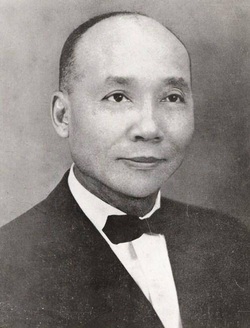 Honorable Elijah Muhammad
Honorable Elijah Muhammad It is also specifically suggested that Dhū ‘l-Suwaygatayn will be a freedman, a status that he may have acquired from the freed people whom he personifies. It is not difficult at all for me to visualize the Most Honorable Elijah Muhammad sitting on a mat on the top of the Ka’bah, with a multitude of Black Americans surrounding it, dismantling the Ka’bah stone by stone. It is also easy for me to envision this Black American conquest of Mecca as the home coming of that land’s real owners, as mentioned by the Honorable Brother Minister Farrakhan in Part 34 of “The Time and What Must Be Done.” Remember also that, according to Abu Hurayra’s warning to the (Muslim) Arabs, it was their violation of the sanctity of the Ka’bah that precipitated the (re-)conquest of Mecca by these Black people. As the Honorable Brother Minister Farrakhan quotes above: “And Allah says He will take the kingdom from whom He pleases and He will give it to whom He pleases. This is the promise of Allah.”
I had all of this material in my databank, but it never really made sense to me until I heard those recent words of my Minister. I know I am at the right place, at the right time. With the right Man.
Why destroy the Ka’bah? The Honorable Brother Minister Farrakhan says wisely:
I asked myself, why would anyone destroy this ancient house of worship for the one true God? And the deeper I thought, I said it could be because that ancient house is a sign of something greater than itself. And when the sign has been fulfilled, then the sign need not be anymore.
What might that sign be? In esoteric Islam (Sufi and Shiite) the Ka’bah is viewed as an architectural image of the body of Adam, the first human, who is the earthly personification and thus vicar of God Himself.[18] As Samer Akkach notes:
In Sufi terms, the Kaʿba’s cube-like form is a crystalization of the cube of man. It is an embodiment of the human as well as cosmic spatial structure and visible manifestation of the three-dimensional cross. Its four arkān (pillars, corners) correspond to the human nature, its six faces to the human figure, and its three dimensions of length, breadth, and depth to the human body.[19]
This homology between sacred architecture and human anatomy is not restricted to the Sufis and mystical Shiites. In fact, it is no doubt cognate with a common architectural tradition of the Hejaz, the area where Mecca and Medina are located. Hisham A.S. Jomah has documented that in traditional Hejazi culture the square/rectangle house was seen as a microcosm of Allah’s created universe (the heavens and the earth) and as a macrocosm of the human shape, which Allah “made beautiful (64:3).[20] As one muʿallem or master-builder from Jedda told him: “The house has eyes, ears, arms, legs, bones, ribs, skin, veins, a chest, a heart, and a stomach…it has a back and a front, a shoulder and a neck.”[21]Jomah thus concludes:
The Hejazi conception of the relationship between microcosm and macrocosm was that man is the image of the universe and vice versa. Both man and the universe were explained reciprocally, one in terms of the other. In traditional Hejazi society, this expressed the idea of a supreme unifying order in the universe which is embodied in man. It is this order that the traditional muʿallem has tried to grasp and interpret in his work (i.e. the square/rectangular houses)…The building process…provides clear evidence of the desire for correspondence between man, universe, and building, each of them a ‘dwelling’ in the true sense.
This recognition and sacred architectural encoding of the correspondence between macrocosm (universe) and microcosm (man) is ancient. It characterized what John M. Lundquist has called “the Common Temple Theology of the Ancient Near East.”[22] I have further documented that the Ka’bah, together with the Solomonic Temple of Jerusalem, the sacred temple of Egypt, and other specifically cubical sacred precincts in the area, is part of an ancient Near Eastern theological tradition according to which the House of God reflected in structure and recapitulated in its details the anthropomorphic body of the God of that house and the story of how that divine body emerged.[23] There is thus sufficient evidence demonstrating a continuous tradition from ancient to modern times of signifying the human/divine body with the cubicoid house of God, including the Ka’bah.
Recognizing that, at least on one level, the Ka’bah signifies both the macrocosm (i.e. the heavens and the earth) and the microcosm, i.e. the body of Adam, the Original Man, the Vicar of God on Earth, Dhū ‘l-Suwaygatayn’s destruction of the Ka’bah by might then be seen in the light of what the Most Honorable Elijah Muhammad teaches us regarding the end-time destruction of the old world, including the Old Man, and the growth of a new world, a new Islam, and a New Man:
He, Master Fard Muhammad, God in Person, will create a new heaven and a new earth, and new Islam and a new government and people. The new earth referred to is a new people who will change the old into such a great future that actually the earth will look like a new earth and a new earth will be made here in what we call America…The awakening or rising of the Black man in America must come first because he is the choice of Allah (God) in the Person of Master Fard Muhammad, for building a new heaven on earth. They are the blindest, deafest and dumbest of people who are without the knowledge of self. They are trod under the foot of civilization as “no people,” as referred to in the Bible and Holy Qur’an. As God created the present heaven and earth out of nothing, so will God, in the Person of Master Fard Muhammad, build a new heaven on earth from nothing (a people who are nothing) so that this world will have no claim on the making of the new heaven on earth…
…What Will Become of the old?
…by no means can He Carry any of the old world into His New Kingdom of Truth, Justice, Equality, and Peace. We must have a new government and a new people to operate the new government (Bible Ez. 18:31)…After the destruction of the old world by fire and by other means of destruction, there is nothing of the old wicked world that can be salvaged to carry into the new world of righteousness…
To make all things new means to go to the very root of everything that exists. We are taught that we ourselves will become a new people. The Holy Qur’an teaches that He would Cause the righteous to grow into a new growth.[24]
A new heaven and a new earth (it will seem to be). Everything will seem to take a change. Even the righteous is promised, a new birth, a new physical birth. As He said to me out of his own mouth that He would cause (when we just submit to him) to grow into a new person, take on a new birth, as we was when we was 15 or 16 years old. That is the way he will make us to grow. No more decay beyond the destruction of this old world. Everyone in the world to come will enjoy peace and youth forever, and their days shall be many. As it is prophesied in your book in Isaiah you’ll find it. And even those that are a hundred years old in [sic] society have there will be nothing but a child. And in another place he says that life shall be as that of a tree, some trees live and continue to produce fruit for thousand of years or more. And some for four or five thousand years. This is the promise to the American so-called Negroes if he will accept his own. Set yourself away from the evil doers.”[25]
From these words of the Most Honorable Elijah Muhammad we learn that the old world will be destroyed and a new world will be produced. Nothing from the old world will be used to build the new, except the Black man of America who had been trodden under by his salve master’s civilization, is sickly and “dead” like the Ḥabashī slave dies in the above hadith dies. He himself, however, will be made new, even a new body. If the Ka’bah represents the heavens and earth and the body of the Old Black Man, we can understand why Dhū ‘l-Suwaygatayn is dismantling it, stone by stone. There will be a new heaven and earth as well as a new body for the New Black Man and his New Islam.
Notes:
[1] For a look at and discussion of this set of hadith see Suliman Bashear, Arabs and Others in Early Islam (Princeton: The Darwin Press, Inc., 1997) 96-101.
[2] Al-Sunan al-Kubrā (Beirut: Dār al-Ma’rifa, 1987) IV:340.
[3] Al-Fākihī (d. 885), Tārīkh Makka, Ms. Leiden, Or. No. 40. 464. Quoted in Bashear,Arabs and Others, 97.
[4] Al-Ḥusayn b. Alī al-Namarī, Kitāb al-mulammaʿ , ed. Wajihah Aḥmad al-Saṭil (Damascus: Majmaʿ al-lugha al-‘arabīyah al-Dimashq, 1976) 1.
[5] Ibn Abī al-Ḥadīd Sharḥ nahj al-balāghah, ed. Muhammad Abi al-Fadl Ibrahim (Cairo: #Isa al-Babi al-Halabi, 1959) V:54.
[6] Ibn Manẓūr, Lisān al-ʿarab, s.v. حمر IV: 209; ibid. s.v. خضر IV: 245.
[7]While abyaḍ/bayāḍ means ‘white’ when used in relation to non-human objects, in relation to whiteness of skin [bayād al-jilda], Ibn Manẓūr quotes al-Tahdhīb: “When Arabs say ‘so-and-so’ is ‘white’ [abyaḍ/bayḍā͗] the meaning is he/she possesses an honor free from defilement and defect.” After further quoting some poetic lines wherein abyaḍ is used to describe Arabs, Ibn Manẓūr (VII:124) says:
and this is found often in (the Arabs) poetry, (but) they don’t intend by this (i.e. abyaḍ) a white complexion. Rather, they intended to glorify with it one’s noble nature and the freedom of his/her honor from defilement and deficit. When they say, ‘so-and-so is white of face (abyaḍ/bayḍā͗ al-wajh)’ they mean the complexion’s freedom from blemish (al-kalaf) and the dishonorable (i.e. excessive) blackness (al-sawād shā͗in).
In other words, when abyaḍ is used by Arabs regarding Arabs, it means both a noble character and a blemish-free complexion, but not usually a white or fair complexion. Al-Zabīdī (ΧΙ: 73) makes the same point:
Arabs don’t say a man is abyaḍ due to white skin. Rather, abyad with them is an appearance free from blemish. When they mean ‘white skin’ they say ahmar.
But the evidence indicates that Classical Arab usage of abyaḍ to describe the Arab complexion meant more than just blemish free skin: it meant blemish-free black skin. According to the important Syrian hadith scholar and historian of Islam, Shāms al-Dīn Abū `Abd Allāh al-Dhahabī (d. 1348), in his Siyar a’lām al-nubalā’ [II:168]:
إِنَّ العَرَبَ إِذَا قَالَتْ: فُلاَنٌ أَبْيَضُ، فَإِنَّهُمْ يُرِيْدُوْنَ الحِنْطِيَّ اللَّوْنِ بِحِلْيَةٍ سَوْدَاءَ،
“When Arabs say, ‘so-and-so is white (abyaḍ),’ they mean a golden brown color on a black physiognomy (al-hintī al-lawn bi-hilya sudā’).”
[8] Ibn Manẓūr, Lisān al-ʿarab (Beirut: Dār al-Ṣādir - Dār al-Bayrūt, 1955-1956) VII:124; Muḥammad Murtaḍá al-Ḥusaynī al-Zabīdī, Tāj al-ʻarūs min jawāhir al-qāmūs , ed. ʻAbd al-Sattār Aḥmad Farrāj, 40. Vols. (Kuwait: Wizārat al-Irshād wa-al-Anbāʾ, 1965-) ΧΙ: 73.
[9] Al-Ṭabarī, Taʾrīkh al-rusul wa’l-mulūk, edd. Michael Jan de Goeje and Lawrence Conrad, Annals of the Apostles and Kings. A Critical Edition Including ‘Arib’sSupplement (Gorgias Press, 2005) vol. I, 220-221; The History of al-ṬabarīVolume II:Prophets and Patriarchs, translated and annotated by William M. Brinner (Alban, NY: State University of New York Press, 1985) 19.
[10] For example the 8th century Pirke De-Rabbi Eliezer, Chapter 23 [28a] (Friedlander edition): “Noah brought his sons and his grandsons, and he blessed them with their (several) settlements, and he gave them as an inheritance all the earth. He especially blessed Shem and his sons, black but comely, and he gave them the inhabitable earth. He blessed Ham and his sons, black like a raven, and he gave them as an inheritance the coast of the sea. He blessed Japheth and his sons, they entirely white, and he gave them for an inheritance the desert and its fields; these (are the inheritances with) which he endowed them.”
[11] Balādhurī, Ansāb, I: 505.
[12] Ibn al-Jawzī, Kitāb tanwīr al-ghabash, 140 [Eng], 307 [Arb].
[13] See my, “The Aryanization of Islam.”
[14] al-Dhahabī (d. 1348), Siyar a’lam al-nubala’ 1: 351; Abbas Mahmud al-Aqqad (d. 1964), Hazrat Bilal (English Adaptation; New Delhi: Islamic Books Service, 2001) 5-6.
[15] Ibn Ḥanbal, Musnad, III:435.
[16] Muḥammad b. Habīb, Kitāb al-Muhabbar, ed. E. Lichtenstädler (Hyderabad, 1361/1942) 306.
[17] Ibn Ḥanbal, Musnad, II:220.
[18] See especially Henry Corbin, Temple and Contemplation London and New York: KPI, 1986); Fritz Meier, “The Mystery of the Ka’ba: Symbol and Reality in Islamic Mysticism,” inThe Mysteries. Papers From the Eranos Yearbooks (Pantheon Books, 1955) 149-168 and below, note 19.
[19] Samer Akkach, Cosmology and Architecture in Premodern Islam: An Architectural Reading of Mystical Ideas (Albany: State University of New York, 2005) 180.
[20] Hisham S.A. Jomah, “The Traditional Hejazi House as a Macrocosm,” in Emily Lyle (ed.),Sacred Architecture in the Traditions of India, China, Judaism and Islam (Edinburgh: Edinburgh Univesity Press, 1992) 151-168.
[21] Jomah, “Traditional Hejazi House,” 156.
[22] John M. Lundquist, “The Common Temple Ideology of the Ancient Near East,” in The Temple in Antiquity: Ancient Records and Modern Perspectives, ed. Truman G. Madsen (Provo, UT: Religious Studies Center, Brigham Young University, 1984), 53–76.
[23]Wesley Muhammad, Egyptian Sacred Science and Islam. A Reappraisal (Atlanta: ATeam Publishing, 2012) 148-157, 171-187.
[24] Elijah Muhammad, Our Saviour Has Arrived (Chicago: Muhammad’s Temple No.2, 1974) 110-119.
[25] The Most Hon. Elijah Muhammad, "Intellectuals, Uncle Toms, and Stool Pigeons.”

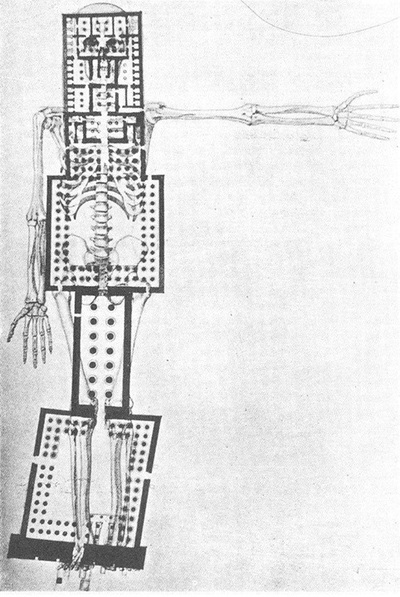

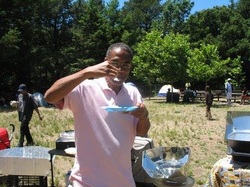
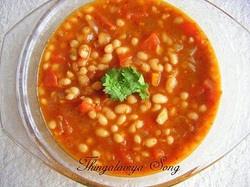
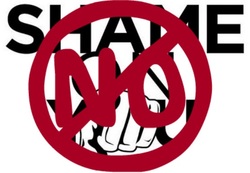
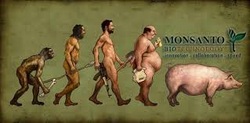
 RSS Feed
RSS Feed
